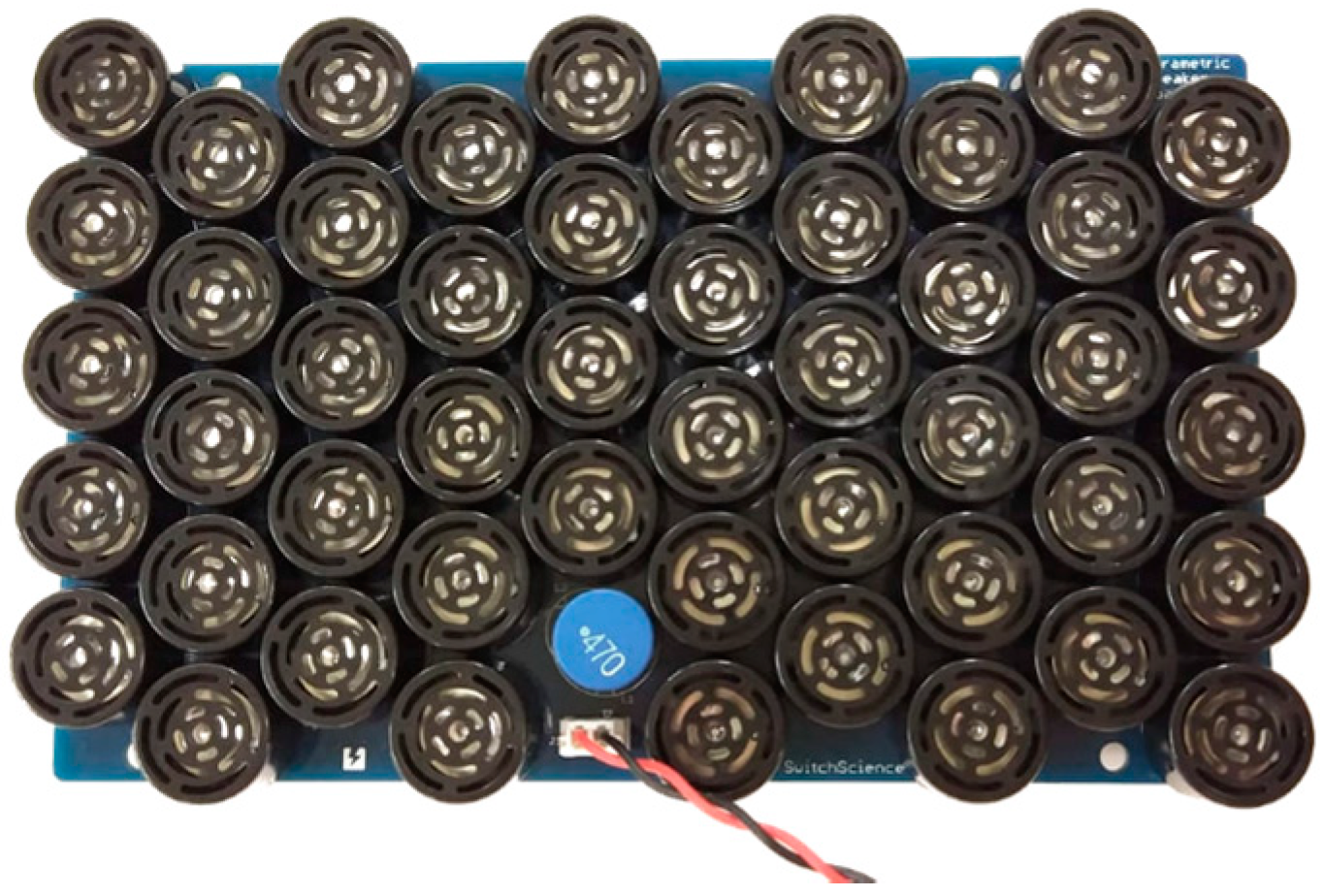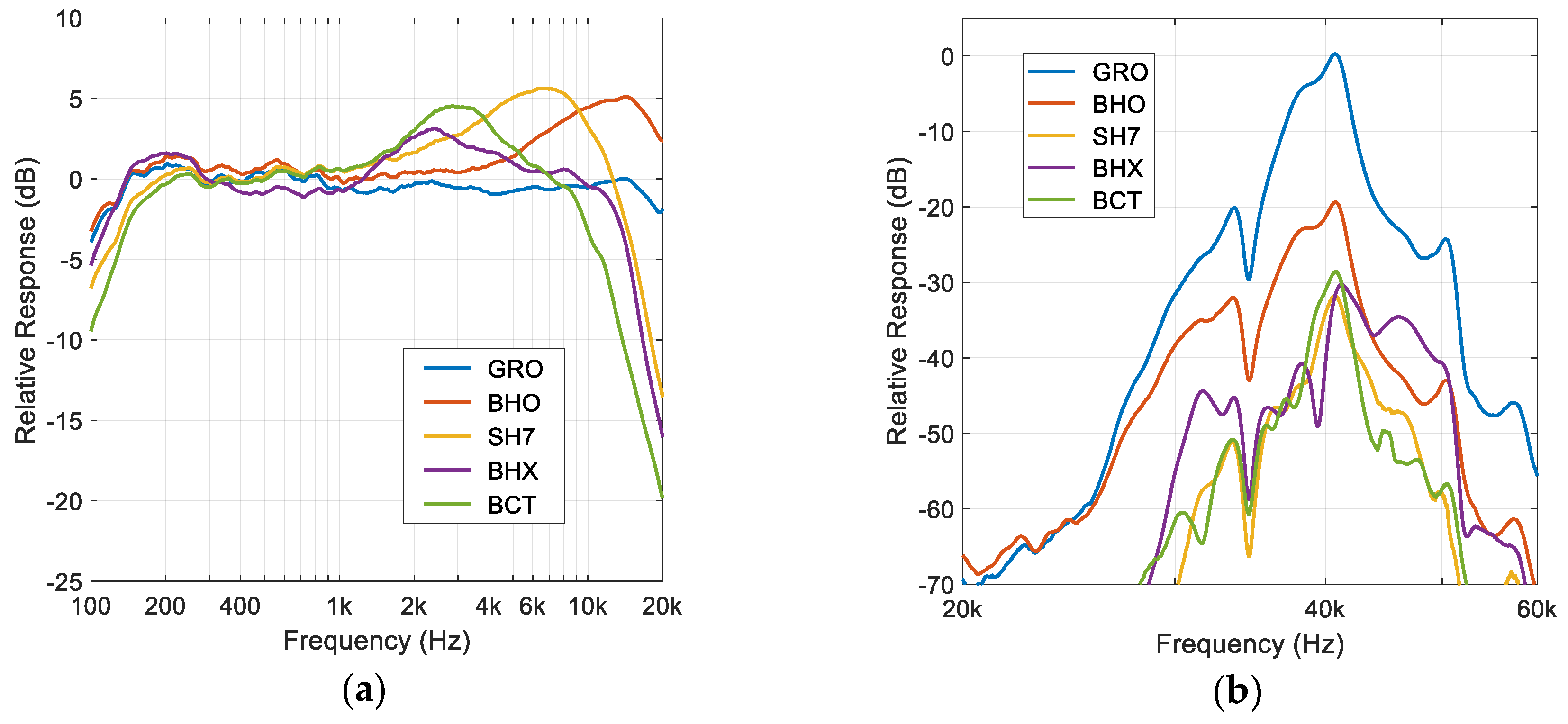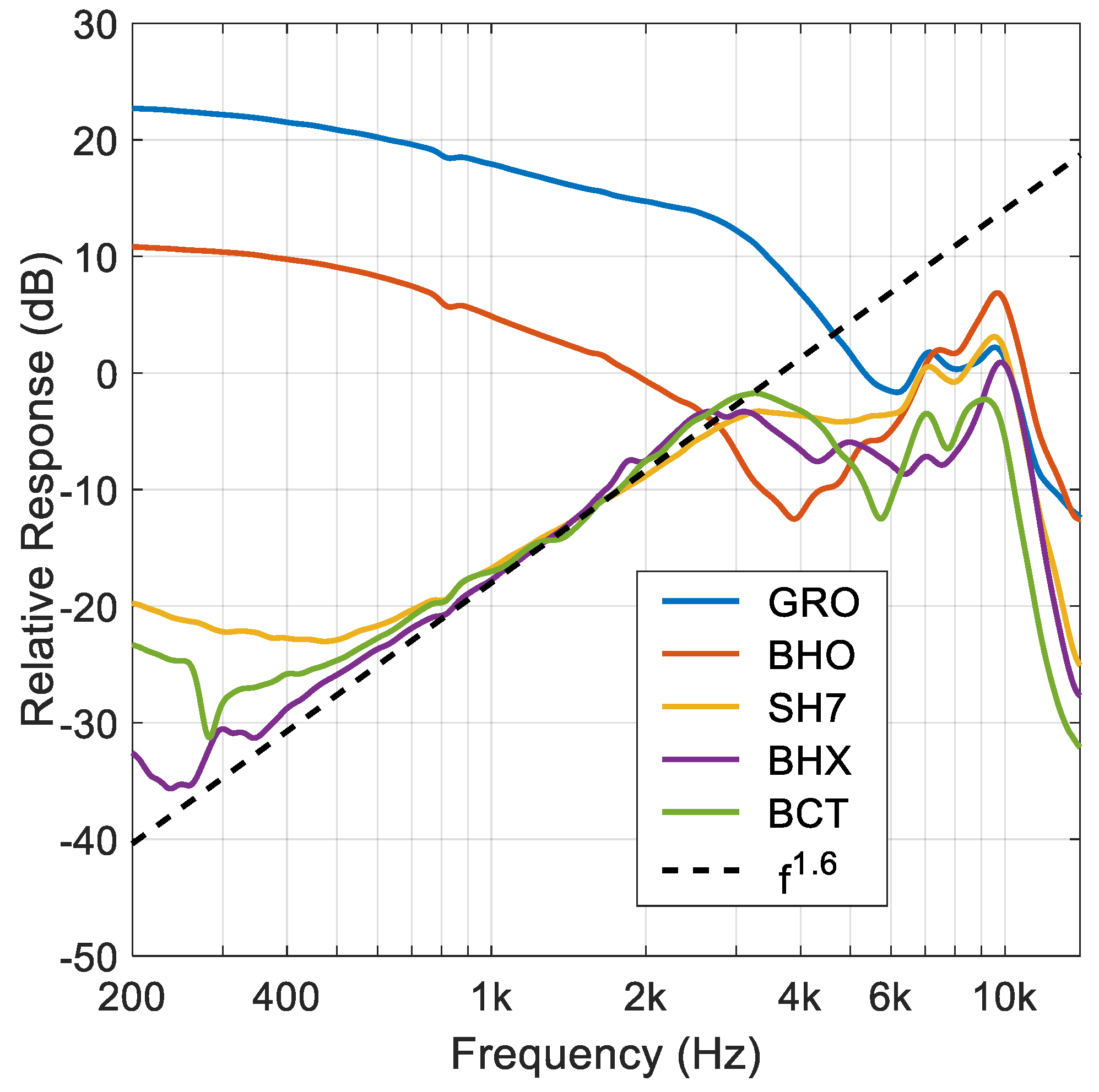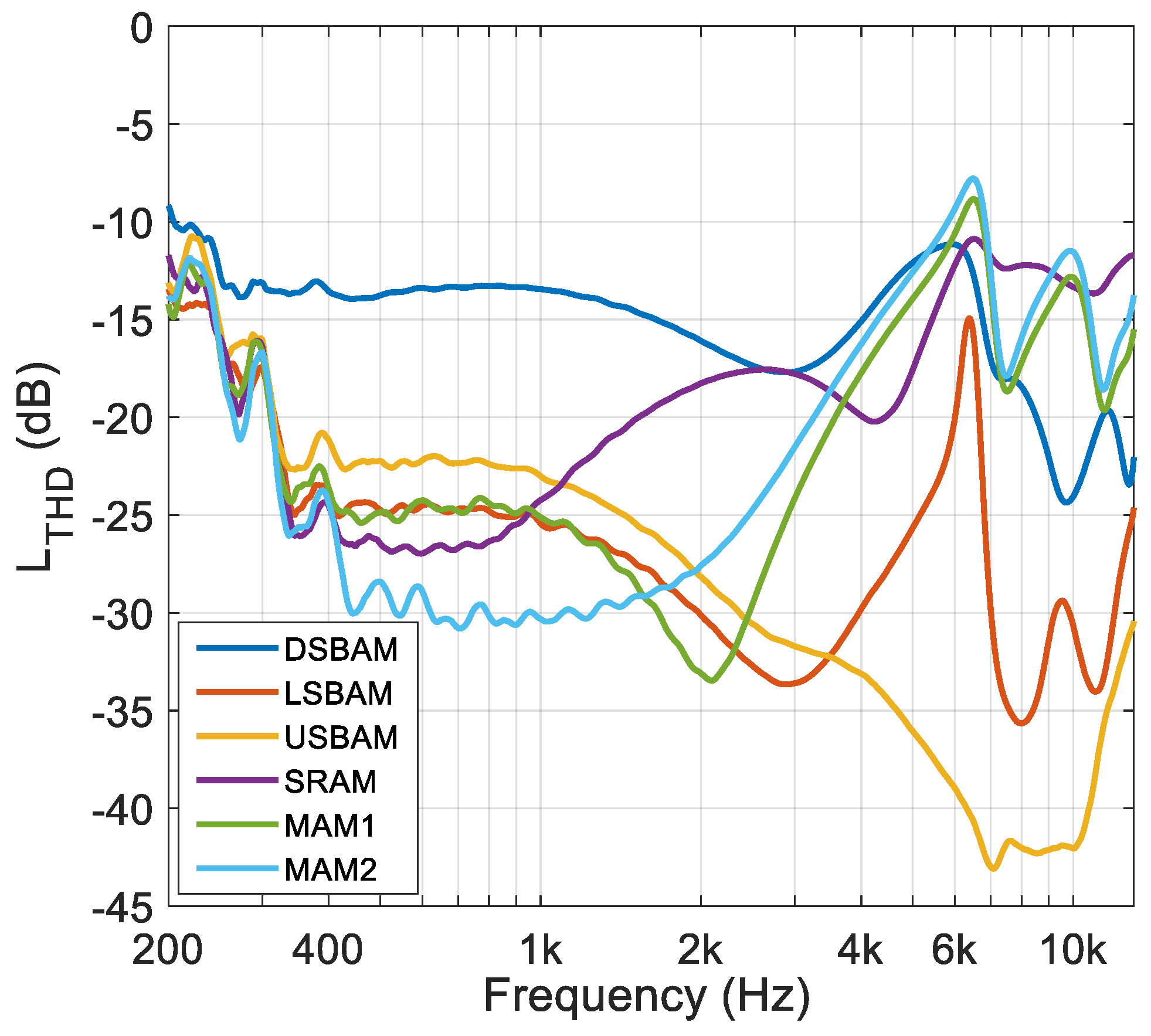Experimental Evaluation of Distortion in Amplitude Modulation Techniques for Parametric Loudspeakers
Abstract
:1. Introduction
2. Materials and Methods
2.1. Experimental Setup
2.2. Measurement Procedure
2.3. Audio Measurements in the Presence of a High-Level Ultrasonic Carrier
2.4. Preprocessing Techniques
3. Results
3.1. Frequency Response
3.2. Harmonic Distortion
3.3. Intermodulation Distortion
4. Conclusions
Supplementary Materials
Author Contributions
Funding
Conflicts of Interest
References
- Gan, W.S.; Yang, J.; Kamakura, T. A review of parametric acoustic array in air. Appl. Acoust. 2012, 73, 1211–1219. [Google Scholar] [CrossRef]
- Ishii, K.; Yamamoto, Y.; Imai, M.; Nakadai, K. A navigation system using ultrasonic directional speaker with rotating base. In Human Interface and the Management of Information. Interacting in Information Environments. Human Interface 2007. Lecture Notes in Computer Science; Smith, M.J., Salvendy, G., Eds.; Springer: Berlin/Heidelberg, Germany, 2007; Volume 4558, pp. 526–535. [Google Scholar] [CrossRef]
- Nakagaki, K.; Kakehi, Y. SonalShooter: A spatial augmented reality system using handheld directional speaker with camera. In Proceedings of the SIGGRAPH’11, ACM SIGGRAPH 2011 Posters, Vancouver, Canada, 2011; ACM Press: New York, NY, USA, 2011. [Google Scholar] [CrossRef]
- Misawa, D. Transparent sculpture: An embodied auditory interface for sound sculpture. In Proceedings of the 7th International Conference on Tangible, Embedded and Embodied Interaction. TEI ’13, Barcelona, Spain, 2013; ACM Press: New York, NY, USA, 2013. [Google Scholar] [CrossRef]
- Gan, W.S.; Tan, E.L.; Kuo, S. Audio Projection. IEEE Signal Process. Mag. 2011, 28, 43–57. [Google Scholar] [CrossRef]
- Westervelt, P.J. Parametric Acoustic Array. J. Acoust. Soc. Am. 1963, 35, 535–537. [Google Scholar] [CrossRef]
- Berktay, H.O. Possible exploitation of non-linear acoustics in underwater transmitting applications. J. Sound Vib. 1965, 2, 435–461. [Google Scholar] [CrossRef]
- Mikulka, J.; Hladký, D.; Sliž, J. Parametric array as a source of audible signal. In Proceedings of the Progress in Electromagnetic Research Symposium (PIERS), Shanghai, China, 8–11 August 2016. [Google Scholar]
- Farias, F.; Abdulla, W. A method for selecting a proper modulation technique for the parametric acoustic array. J. Phys. Conf. Ser. 2018, 1075, 012035. [Google Scholar] [CrossRef]
- Ji, W.; Gan, W.S.; Ji, P. Theoretical and experimental comparison of amplitude modulation techniques for parametric loudspeakers. In Proceedings of the 128th Audio Engineering Society Convention, London, UK, 22–25 May 2010. [Google Scholar]
- IEC 60268-21:2018 Sound system equipment—Part 21: Acoustical (output-based) measurements; International Electrotechnical Commission: Geneva, Switzerland, 2018.
- Berzborn, M.; Bomhardt, R.; Klein, J.; Richter, J.G.; Vorländer, M. The ITA-Toolbox: An Open Source MATLAB Toolbox for Acoustic Measurements and Signal Processing. In Proceedings of the 43th Annual German Congress on Acoustics, Kiel, Germany, 6–9 March 2017. [Google Scholar]
- Ji, P.; Yang, J. An experimental investigation about parameters’ effects on spurious sound in parametric loudspeaker. Appl. Acoust. 2019, 148, 67–74. [Google Scholar] [CrossRef]
- Bennett, M.B.; Blackstock, D.T. Experimental verification of the parametric array in air. J. Acoust. Soc. Am. 1973, 54, 297. [Google Scholar] [CrossRef]
- Lucas, B.G.; Tjötta, J.N.; Muir, T.G. Field of a parametric focusing source. J. Acoust. Soc. Am. 1983, 73, 1966–1971. [Google Scholar] [CrossRef]
- Kamakura, T.; Yoneyama, M.; Ikegaya, K. Developments of parametric loudspeaker for practical use. In Proceedings of the 10th International Symposium on Nonlinear Acoustics, Kobe, Japan, 24–28 July 1984; pp. 147–150. [Google Scholar]
- Havelock, D.; Brammer, A. Directional loudspeakers using sound beams. J. Audio Eng. Soc. 2000, 48, 908–916. [Google Scholar]
- Toda, M. New type of acoustic filter using periodic polymer layers for measuring audio signal components excited by amplitude-modulated high-intensity ultrasonic waves. J. Audio Eng. Soc. 2005, 53, 930–941. [Google Scholar]
- Wygant, I.O.; Kupnik, M.; Windsor, J.C.; Wright, W.M.; Wochner, M.S.; Yaralioglu, G.G.; Hamilton, M.; Khuri-Yakub, P. 50 kHz capacitive micromachined ultrasonic transducers for generation of highly directional sound with parametric arrays. IEEE Trans. Ultrason. Ferroelectr. Freq. Control 2009, 56, 193–203. [Google Scholar] [CrossRef] [PubMed]
- Ye, C.; Kuang, Z.; Wu, M.; Yang, J. Development of an acoustic filter for parametric loudspeaker in air. Jpn. J. Appl. Phys. 2011, 50, 07HE18. [Google Scholar] [CrossRef]
- Ji, P.; Hu, W.; Yang, J. Development of an acoustic filter for parametric loudspeaker using phononic crystals. Ultrasonics 2016, 67, 160–167. [Google Scholar] [CrossRef] [PubMed]
- Hedberg, C.M.; Haller, K.C.E.; Kamakura, T. A self-silenced sound beam. Acoust. Phys. 2010, 56, 637–639. [Google Scholar] [CrossRef]
- Ji, P.; Liu, W.; Wu, S.; Yang, J.; Gan, W.S. An alternative method to measure the on-axis difference-frequency sound in a parametric loudspeaker without using an acoustic filter. Appl. Acoust. 2012, 73, 1244–1250. [Google Scholar] [CrossRef]
- Ju, H.S.; Kim, Y.H. Near-field characteristics of the parametric loudspeaker using ultrasonic transducers. Appl. Acoust. 2010, 71, 793–800. [Google Scholar] [CrossRef]
- Berktay, H.O.; Leahy, D.J. Farfield performance of parametric transmitters. J. Acoust. Soc. Am. 1974, 55, 539–546. [Google Scholar] [CrossRef]
- Yang, J.; Tian, J.; Gan, W.S. Parametric loudspeaker: From theory to applications. In Proceedings of the 21st International Congress on Sound and Vibration, ICSV, Beijing, China, 13–17 July 2014. [Google Scholar]
- Yoneyama, M.; Fujimoto, J.; Kawamo, Y.; Sasabe, S. The audio spotlight: An application of nonlinear interaction of sound waves to a new type of loudspeaker design. J. Acoust. Soc. Am. 1983, 73, 1532–1536. [Google Scholar] [CrossRef]
- Aoki, K.; Kamakura, T.; Kumamoto, Y. Parametric loudspeaker—Characteristics of acoustic field and suitable modulation of carrier ultrasound. Electron. Commun. Jpn. (Part III: Fundam. Electron. Sci.) 1991, 74, 76–82. [Google Scholar] [CrossRef]
- Kite, T.D.; Postt, J.T.; Harnilton, M.F. Parametric array in air: Distortion reduction by preprocessing. J. Acoust. Soc. Am. 1998, 103, 2871. [Google Scholar] [CrossRef]
- Tan, E.L.; Gan, W.S.; Yang, J. Preprocessing techniques for parametric loudspeakers. In Proceedings of the International Conference on Audio, Language and Image Processing ICALIP, Shanghai, China, 7–9 July 2008. [Google Scholar]
- Hatano, Y.; Shi, C.; Kajikawa, J. Compensation for nonlinear distortion of the frequency modulation-based parametric array loudspeaker. IEEE/ACM Trans. Audio Speech Lang. Process. 2017, 25, 1709–1717. [Google Scholar] [CrossRef]
- Nakayama, M.; Nishiura, T. Synchronized amplitude-and-frequency modulation for a parametric loudspeaker. In Proceedings of the 9th Asia-Pacific Signal and Information Processing Association Annual Summit and Conference, APSIPA ASC, Kuala Lumpur, Malaysia, 12–15 December 2017. [Google Scholar]
- Pompei, F.J. The use of airborne ultrasonics for generating audible sound beams. J. Audio Eng. Soc. 1999, 47, 726–731. [Google Scholar]
- Farina, A. Simultaneous measurement of impulse response and distortion with a swept-sine technique. In Proceedings of the AES 108th Convention, Paris, France, 19–22 February 2000. [Google Scholar]
- Müller, S.; Massarani, P. Transfer-Function measurement with sweeps. J. Audio Eng. Soc. 2001, 49, 443–471. [Google Scholar]







© 2020 by the authors. Licensee MDPI, Basel, Switzerland. This article is an open access article distributed under the terms and conditions of the Creative Commons Attribution (CC BY) license (http://creativecommons.org/licenses/by/4.0/).
Share and Cite
San Martín, R.; Tello, P.; Valencia, A.; Marzo, A. Experimental Evaluation of Distortion in Amplitude Modulation Techniques for Parametric Loudspeakers. Appl. Sci. 2020, 10, 2070. https://doi.org/10.3390/app10062070
San Martín R, Tello P, Valencia A, Marzo A. Experimental Evaluation of Distortion in Amplitude Modulation Techniques for Parametric Loudspeakers. Applied Sciences. 2020; 10(6):2070. https://doi.org/10.3390/app10062070
Chicago/Turabian StyleSan Martín, Ricardo, Pablo Tello, Ana Valencia, and Asier Marzo. 2020. "Experimental Evaluation of Distortion in Amplitude Modulation Techniques for Parametric Loudspeakers" Applied Sciences 10, no. 6: 2070. https://doi.org/10.3390/app10062070
APA StyleSan Martín, R., Tello, P., Valencia, A., & Marzo, A. (2020). Experimental Evaluation of Distortion in Amplitude Modulation Techniques for Parametric Loudspeakers. Applied Sciences, 10(6), 2070. https://doi.org/10.3390/app10062070





